Rust Family Foundation: Archaeology Grants Program
Chosen for Death: Preliminary Results from a Study of Human Sacrifices from the Moche Valley, Peru
Principal Investigator: Rachel G. Witt
Department of Anthropology, Tulane University
This report documents the preliminary results for the PI’s dissertation research conducted during the 2019 season in the Chimú site of El Pollo, located near Trujillo, Peru (figs.1-3), and results of stable isotope analysis of human bone and enamel. Human sacrifice was one of the incipient fascinations in early anthropological scholarship and continues to contribute to discussions on the origins and development of religion. Recent s
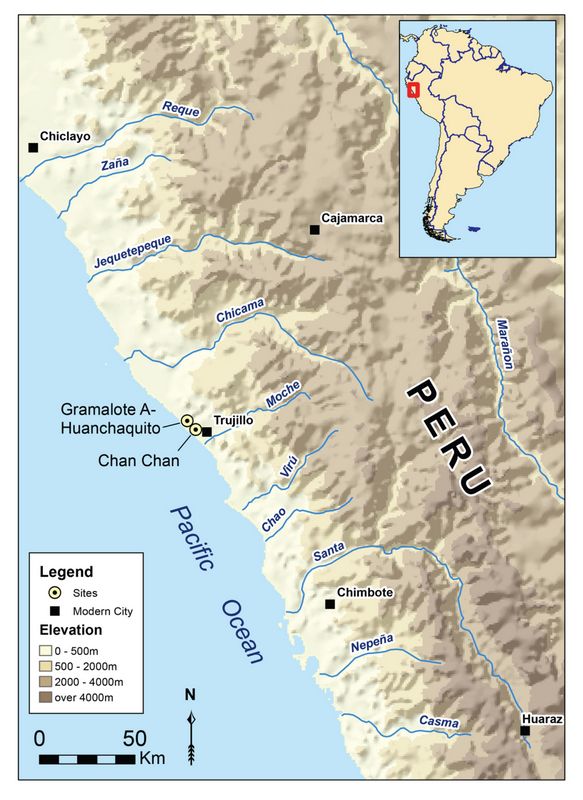 cholarship has
argued that human sacrifice played a vital role in the emergence and
maintenance of hierarchical societies (Schwartz 2017, Trigger
2003:484-485, Watts et al. 2016), and stood as an important piece of
political theatre which consolidated, legitimated, and sustained elite
power in the Middle East (Akkermans and Schwartz 2003, Lloyd 2010,
Pollock 1999, Schug et al. 2012), Asia (Cheung et al. 2017), North
America (Holt 2009), Central America (Carrasco 1999), and Andean South
America (Tung 2012). Despite rigorous scholarship, previous studies
have focused on how male sacrifice maintains social institutions and
apparatuses of power and in doing so neglected critical discussions on
how sacrifice of other demographic groups with minimal power such as
migrants, women, and children is used to consolidate power.
cholarship has
argued that human sacrifice played a vital role in the emergence and
maintenance of hierarchical societies (Schwartz 2017, Trigger
2003:484-485, Watts et al. 2016), and stood as an important piece of
political theatre which consolidated, legitimated, and sustained elite
power in the Middle East (Akkermans and Schwartz 2003, Lloyd 2010,
Pollock 1999, Schug et al. 2012), Asia (Cheung et al. 2017), North
America (Holt 2009), Central America (Carrasco 1999), and Andean South
America (Tung 2012). Despite rigorous scholarship, previous studies
have focused on how male sacrifice maintains social institutions and
apparatuses of power and in doing so neglected critical discussions on
how sacrifice of other demographic groups with minimal power such as
migrants, women, and children is used to consolidate power.Fig.1: Location of El Pollo and Chan Chan on the north coast of Peru.
A tradition of infant and child sacrifice has a long history in the prehistoric Andes from the Preceramic (5000-1800 BC) to the Late Horizon (AD 1476-1534). The most well-known examples are the frozen bodies of sacrificed children found at high altitude archaeological sites in Chile, Argentina, and Peru, dating to the Late Horizon. Victims were children chosen to as part of the qhapac hucha (capacocha or capac huacha) ritual and served as significant cultural markers of gender and tributes for the Inka Empire (AD 1450-1532) (Reinhard and Ceruti, 2005). The ritual was performed on momentous occasions including the death of an Inka ruler, at the beginning or end of agricultural cycles, and during times of crisis (Cobo, 1990 [1653]).
Recent discoveries of the largest example of child sacrifice ever documented in the Americas by the Huanchaco Archaeological Program illustrate the prevalence of violence against children carried out by the Chimú Empire. The Chimú Empire is characterized as one of the largest pre-Hispanic empires in South America that emerged around AD 1100 and expanded throughout much of the north coast of Peru until it was conquered by the Inka Empire in AD 1470. The Chimú Empire was a highly stratified society controlled by ruling elites at the coastal capital city Chan Chan. After consolidating their core
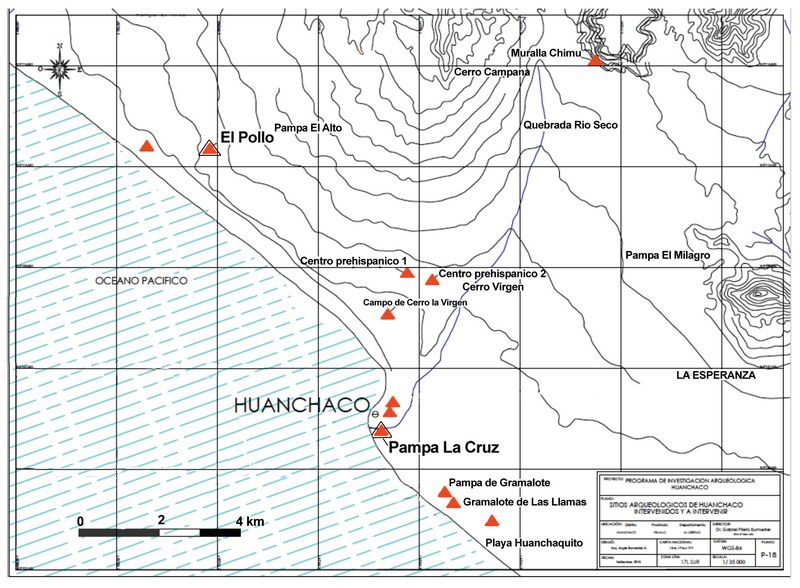 territory in the Moche Valley, the Chimú shifted to an imperial
strategy that involved the creation of new settlements and
incorporation of local nobles into Chimú administration throughout the
coast and into the neighboring highlands. In this way, the Chimú were
able to maintain control over lower-level, compliant communities
through the extraction of foreign resources and appropriation of land
(Moore and Mackey 2008).
territory in the Moche Valley, the Chimú shifted to an imperial
strategy that involved the creation of new settlements and
incorporation of local nobles into Chimú administration throughout the
coast and into the neighboring highlands. In this way, the Chimú were
able to maintain control over lower-level, compliant communities
through the extraction of foreign resources and appropriation of land
(Moore and Mackey 2008).Fig.2: Map showing locations of El Pollo, Pampa la Cruz, and Huanchaquito-Las Llamas, Huanchaco, Peru. (Courtesy of Dr. Gabriel Prieto.)
After the Inka armies overpowered and conquered the Chimú, the Inka acquired the vast north coast region rich in natural and agricultural resources with a large population already organized to provide tribute to imperial rulers. The Inka took advantage of the existing trade networks, production systems, and administrative infrastructure and modified it to pull the north coast into the Inka political and economic sphere. This change is evidenced by the remodeling of state installations (at Farfán in the Jequetepeque Valley and Chiquitoy Viejo in the Chicama Valley), the construction of roads, irrigation networks, and pottery-manufacturing loci (e.g. Tambo Real and La Viña) (Hayashida and Guzmán 2015, Mackey and Nelson 2020).
Bioarchaeological evidence from settlements outside the capital indicates that Chimú expansion involved violent conquest followed by the imposition of imperial rule (see Klaus et al. 2016, Toyne 2011). Following Inka conquest, the mode of sacrifice characteristic of the Late Intermediate Period appears to have persisted in the former Chimú heartland and at major centers. At the political and religion center Chotuna-Chornancap (lower Lambayeque valley), evidence of sacrifice in the form of throat-slitting and chest mutilation observed during in the Chimú occupation (ca. 1375-1470) continues during the Inka occupation of the center (AD 1470-1432) (Klaus et al. 2016). Similarly, human and camelid sacrifice was conducted during Chimú and Inka occupations at the Temple at Túcume. Toyne (2011) found that ritual violence involving throat-slitting, chest-opening, and severing the heads of nonadults and adult males persisted during both occupations.
Previous Research:
Since 2012, the Huanchaco Archaeological Program has discovered over three hundred sacrificed children at the sites of Huanchaquito-Las Llamas, Pampa la Cruz, and El Pollo, all located within 5 km of the Chimú Empire’s capital city Chan Chan in the Moche Valley on the north coast of Peru (Prieto et al. 2019). The site of Huanchaquito-Las Llamas is located in the modern-day city of Huanchaco, 10 km from the center of the modern city of Trujillo (fig.2). Excavations at Huanchaquito- Las Llamas unearthed a massive sacrifice deposit with 137 humans (primarily children and adolescents) and over 200 llama skeletons (Prieto et al. 2019). Radiocarbon dates from Huanchaquito-Las Llamas indicate that the sacrifices date to AD 1400-1450, a period characterized as the height of Chimú expansion.
The Huanchaco Archaeological Program is currently continuing work at the newly discovered site of Pampa la Cruz in the Moche Valley where long-standing traditions of ritual sacrifice have similarly been documented. As of 2019, estimated totals of victims include more than 260 humans and almost 300 llamas. Like Huanchaquito- Las Llamas, the individuals exhibit transected sternebrae consistent with chest-opening (fig.3) and exhib
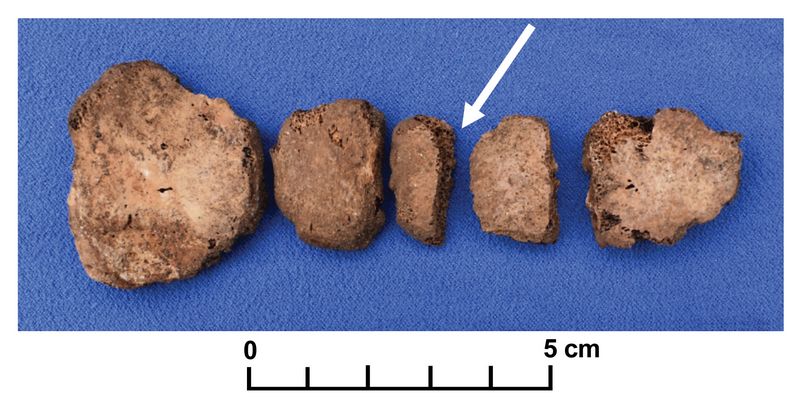 it multiple cranial modification types. Prieto and colleagues
(2021) argue that at least six discrete sacrificial events occurred at
Pampa la Cruz, beginning as early as AD 1000/1050 and continued
following the Inka conquest and occupation of the region (AD
1450-1500).
it multiple cranial modification types. Prieto and colleagues
(2021) argue that at least six discrete sacrificial events occurred at
Pampa la Cruz, beginning as early as AD 1000/1050 and continued
following the Inka conquest and occupation of the region (AD
1450-1500). Fig.3: E104 non-adult with transected sternebrae from El Pollo, characteristic of injuries documented at child sacrifice sites of Pampa la Cruz and Huanchaquito-Las Llamas.
Recent research conducted by members of the Huanchaco Archaeological Program in the Moche Valley has led to additional evidence that rituals of human sacrifice were a long-lasting tradition that continued after Inka conquest. The recent discoveries of human and camelid sacrifices at El Pollo provide additional evidence that these rituals began under the Chimú regime and continued during the Late Horizon. By contextualizing new data gleaned during excavations, osteological, and stable isotope analysis from El Pollo, this work aims to identify and address the elements of sacrifice performed at this structure and reconstruct the life histories of victims sacrificed. Doing so will allow us to (1) elucidate why the Chimú Empire facilitated these sacrificial performances targeting children near the capital and (2) understand impact of and local responses to Inka imperialism, especially its effects on long-standing Chimú traditions of ritual sacrifice.
Preliminary results of project (RFF-2019-110)
Significant progress was made in collecting data during the 2019 summer field season at the site of El Pollo, located 4 km outside Huanchaco,
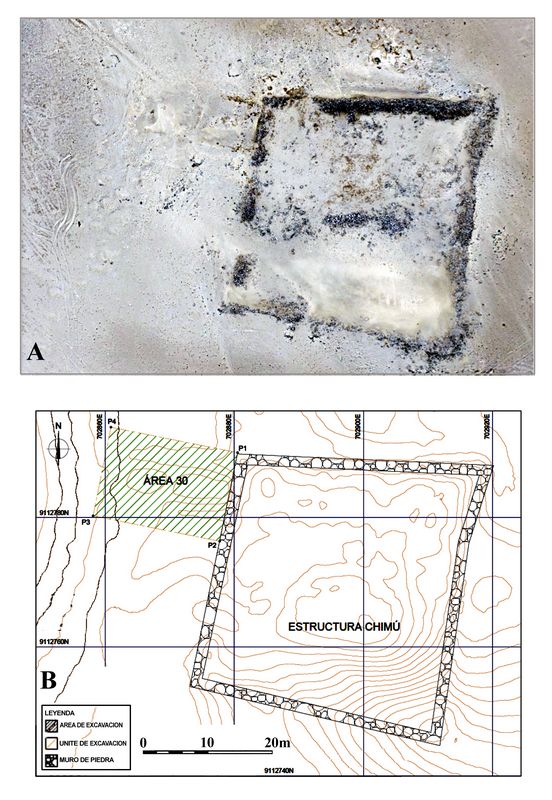 Peru
from June 23 -August 25, 2019. Preliminary results from research
conducted during the 2019 field season reveal similarities to
Huanchaquito-Las Llamas and Pampa la Cruz together with notable
differences. El Pollo differs from
the other two sites in that it
consists of a massive, quadrangular structure constructed from unworked
stone, measuring approximately 40 by 38 meters (fig.4A).
Peru
from June 23 -August 25, 2019. Preliminary results from research
conducted during the 2019 field season reveal similarities to
Huanchaquito-Las Llamas and Pampa la Cruz together with notable
differences. El Pollo differs from
the other two sites in that it
consists of a massive, quadrangular structure constructed from unworked
stone, measuring approximately 40 by 38 meters (fig.4A). Fig.4A: Areal view of El Pollo.
Fig.4B: Plan showing Area 30 at El Pollo. (Images courtesy of Feren Castillo Lujan).
Surface collection within the structure and excavations in Area 30 at El Pollo (fig.4B) documented numerous artifacts, including diagnostic Chimú stirrup spout ceramics, copper fragments, pods of Nectandra sp. seeds (fig.5), and exotic items such as Spondylus shell.
Excavations in Area 30 revealed 78 llama skeletons and 50 complete or nearly complete human interments, along with comingled human and llama remains. The majority of individuals are oriented east-west and face east towards the quadrangular structure. Three adult males (35 yrs+) were found face-down or extended on their backs with their limbs bound by rope.
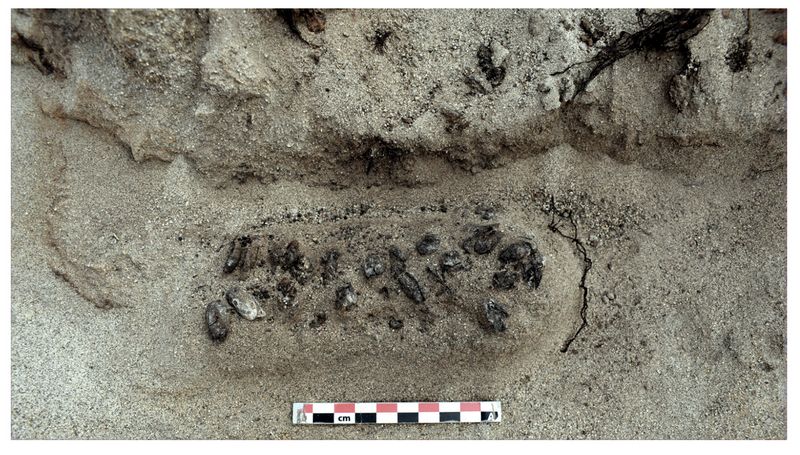 Only one female was identified at El Pollo, and she was the only
individual to be found in the seated, flexed position with the head
tucked towards the thorax and pelvis. She was deposited with textiles
around her head and pods of seeds from the Nectandra sp. plant, which is indigenous to the Amazon Rainforest (fig.5).
Only one female was identified at El Pollo, and she was the only
individual to be found in the seated, flexed position with the head
tucked towards the thorax and pelvis. She was deposited with textiles
around her head and pods of seeds from the Nectandra sp. plant, which is indigenous to the Amazon Rainforest (fig.5). Fig.5: Middle Adult Female burial with Nectandra seeds, El Pollo.
Radiocarbon dates taken from six organic materials indicate that humans and camelids were interred outside the structure for a 200-year time span, the earliest
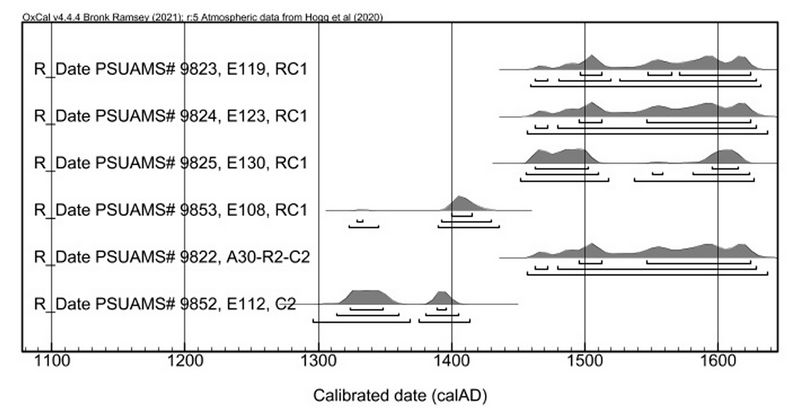 occurring around AD 1300-1350, and the latest around AD
1500-1550 (table 1).
occurring around AD 1300-1350, and the latest around AD
1500-1550 (table 1). Table 1: Radiocarbon dates from El Pollo.
The radiocarbon dates and contextual data indicate that victims were deposited during four distinct ritual events. The first two events occurred during the Chimú reign of the north coast (AD 1300-1350 and AD 1400-1450) and correspond roughly to the initial wave of Chimú incorporation of regions outside the Moche Valley and later at the height of Chimú expansion. The second two events occurred during or shortly after Inka conquest of the region (AD 1450-1500 and AD 1500-1550).
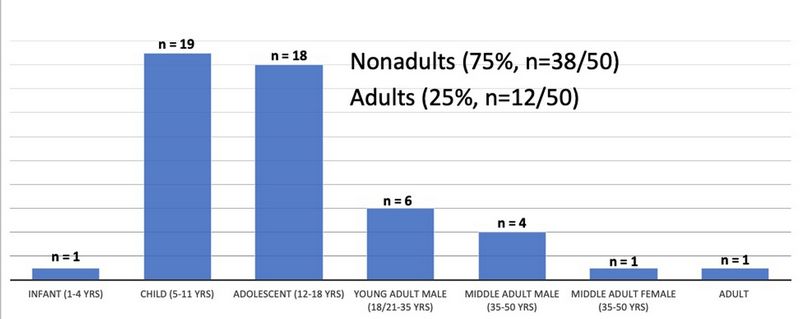 Osteological analysis detailed here
shows that nonadults dominate the sample representing 75% of the
assemblage (n=38/50), with adults representing only 25% of the humans
interred at El Pollo (n=12/50) (fig.6).
Osteological analysis detailed here
shows that nonadults dominate the sample representing 75% of the
assemblage (n=38/50), with adults representing only 25% of the humans
interred at El Pollo (n=12/50) (fig.6).Fig.6: Chart showing range of non-adult and adult Ages-at-Death at El Pollo.
Sharp-force trauma on the thorax (sternum and ribs) is the predominate type of trauma documented at El Pollo, with transverse cuts to the sternum and/or cutmarks to the ribs present on 80% of the individuals. 85% of nonadults exhibit sharp-force trauma to the thorax (n=32/38), along with five young adult males (n=5/5), one middle adult male (n=1/4), and one adult male (n=1/1) (fig.7). None of the males found bound by ropes exhibit sharp force trauma to the thorax. The one female did not exhibit any sharp-force trauma to the thorax.

Fig.7: Graph of Cutmarks on Thorax based on Age-at-Death at El Pollo.
Among these 35 individuals with observable crania, over 54% of adults and nonadults exhibit cranial modification (n=19/35, figs.9-10). Occipital flattening or fronto-occipital flattening achieved by a cradelboarding apparatus is the most
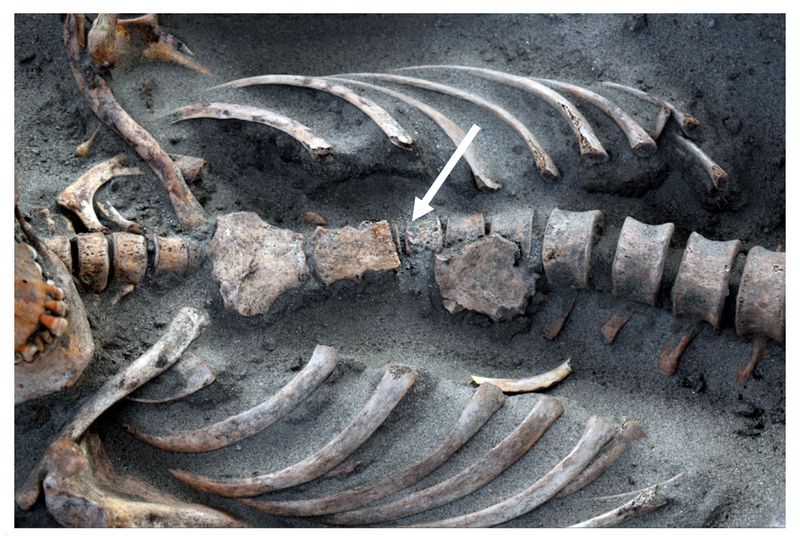 common modification type among nonadults and adults (n=14/35).
Modification achieved through padding or wrappings occurs at a lower
frequency (n=5/35). The only individual with annular modification found
at El Pollo is an adolescent (n=1/15). Individuals with and without
cranial modification exhibit sharp force trauma to the thorax, with no
single modification type exclusively exhibiting or lacking sharp force
trauma. The number of individuals with cranial modification is higher
(> ~20%) than that documented at Huanchaquito-Las Llamas and Pampa
la Cruz.
common modification type among nonadults and adults (n=14/35).
Modification achieved through padding or wrappings occurs at a lower
frequency (n=5/35). The only individual with annular modification found
at El Pollo is an adolescent (n=1/15). Individuals with and without
cranial modification exhibit sharp force trauma to the thorax, with no
single modification type exclusively exhibiting or lacking sharp force
trauma. The number of individuals with cranial modification is higher
(> ~20%) than that documented at Huanchaquito-Las Llamas and Pampa
la Cruz. Fig.8: Cut thorax on Young Adult Male E 110, El Pollo.
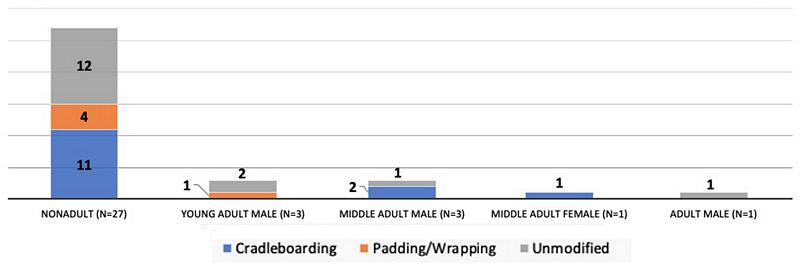
Fig.9: Distribution of Cranial Modification based on Age-at-Death at El Pollo.
One non-adult exhibited evidence of antemortem (before death) trauma on the cranium (fig.10a).

Fig.10a: Skull E104 non-adult with healed (antemortem) trauma on the right frontal bone.
Fig.10b: E115 with annular modification at El Pollo, typical of the highlands of Peru.
Fig.10c: E120 with occipital flattening at El Pollo, typical of the coast of Peru.
Perimortem (sustained at or around the time of death) trauma on one middle adult male was documented on the acromion process of the left scapula (fig.11).
O
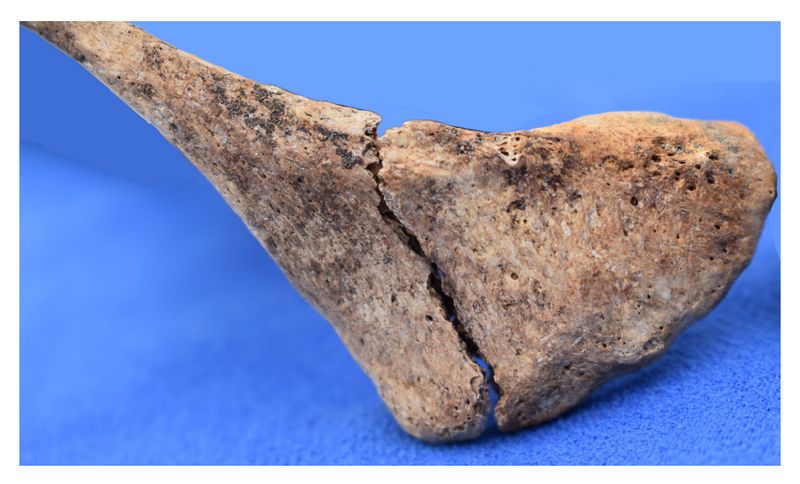 verall, there was little evidence of degenerative joint
disease and nonspecific physiological stress on the non-adults,
indicating that individuals were generally of good health. Among the
small sample of adults, degenerative joint conditions on the clavicles
(pronounced costal impressions) and vertebrae (osteophytes) were
documented.
verall, there was little evidence of degenerative joint
disease and nonspecific physiological stress on the non-adults,
indicating that individuals were generally of good health. Among the
small sample of adults, degenerative joint conditions on the clavicles
(pronounced costal impressions) and vertebrae (osteophytes) were
documented.Fig.11: E112 middle adult male with perimortem fracture on acromion process of left scapula.
Stable Isotope Analysis Results
Stable isotope results from bone collagen from a subsample of victims from Pampa la Cruz and El Pollo reveal diets that consist primarily of C4 plants and protein-rich resources (fig.12). Botanica
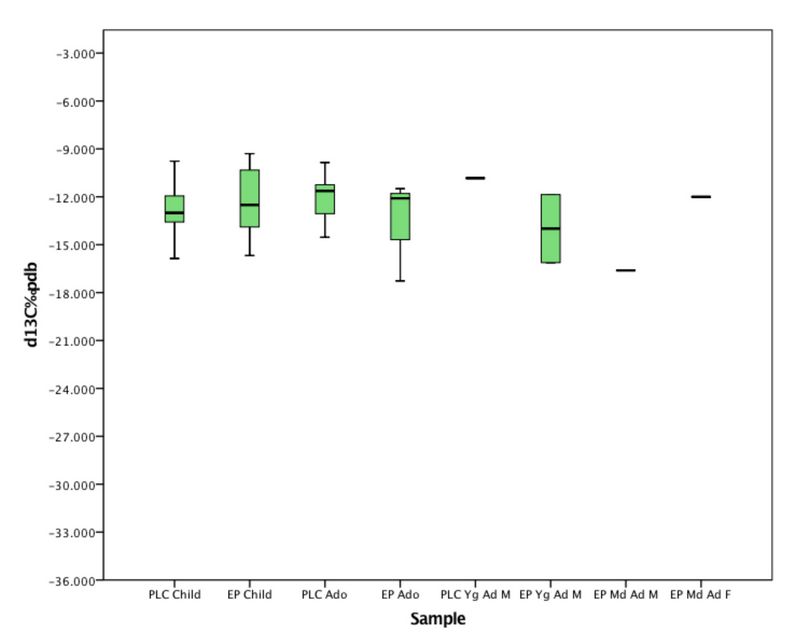 l data from
numerous sites in the Moche Valley (including SIAR sector of Chan Chan,
Choroval, Cerro la Virgen, La Joyada) indicate that this pattern is
perhaps attributed to preferential consumption of maize (Billman, et
al., 2020, Domínguez Vergara, 2019, Pozorski, 1979).
l data from
numerous sites in the Moche Valley (including SIAR sector of Chan Chan,
Choroval, Cerro la Virgen, La Joyada) indicate that this pattern is
perhaps attributed to preferential consumption of maize (Billman, et
al., 2020, Domínguez Vergara, 2019, Pozorski, 1979). Fig.12: Boxplot of δ13C‰ ranges of victims from Pampa la Cruz (PLC) and El Pollo (EP) by age-at-death and sex (CHD: child, ADO: adolescent, YAM: young adult male, MAM: middle adult male, MAF: middle adult female).
The range of all nitrogen values indicate that individuals were consuming protein-rich resources (fig.13). Zooarchaeological data from numerous sites in the Moche Valley (including SIAR sector of Chan Chan, Choroval, Caracoles, Cerro la Virgen, La Joyada) indicate that this pattern is perhaps attributed to preferential consumption of marine invertebrates and marine fish, coastal camelids, dogs, and/or guinea pigs
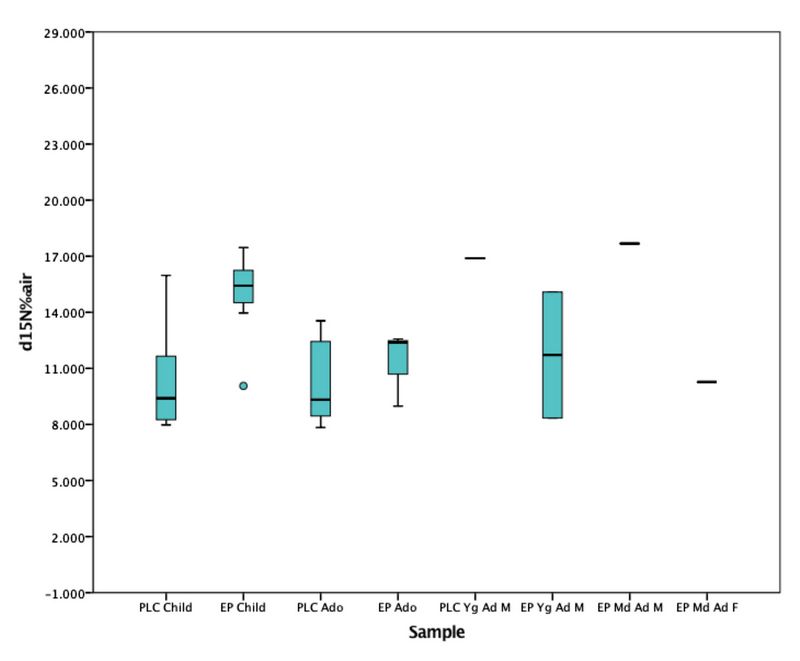 (Billman, et al., 2020, Domínguez Vergara, 2019, Pozorski, 1979).
The enrichment of nitrogen observed here may also indicate that
cultivated plants were fertilized using seabird guano or is a result of
the high aridity and low precipitation characteristic of low attitude
regions like the coast of Peru (see Spzak et al. 2012, 2013). Of
course, given the proximality of El Pollo to the ocean and the abundant
evidence of marine refuse from several nearby sites in the Moche
Valley, it is also likely that the values revealed here reflect
consumption of marine resources.
(Billman, et al., 2020, Domínguez Vergara, 2019, Pozorski, 1979).
The enrichment of nitrogen observed here may also indicate that
cultivated plants were fertilized using seabird guano or is a result of
the high aridity and low precipitation characteristic of low attitude
regions like the coast of Peru (see Spzak et al. 2012, 2013). Of
course, given the proximality of El Pollo to the ocean and the abundant
evidence of marine refuse from several nearby sites in the Moche
Valley, it is also likely that the values revealed here reflect
consumption of marine resources. Fig.13: Boxplot of δ15N‰ ranges of victims from Pampa la Cruz (PLC) and El Pollo (EP) by age-at-death and sex (CHD: child, ADO: adolescent, YAM: young adult male, MAM: middle adult male, MAF: middle adult female).
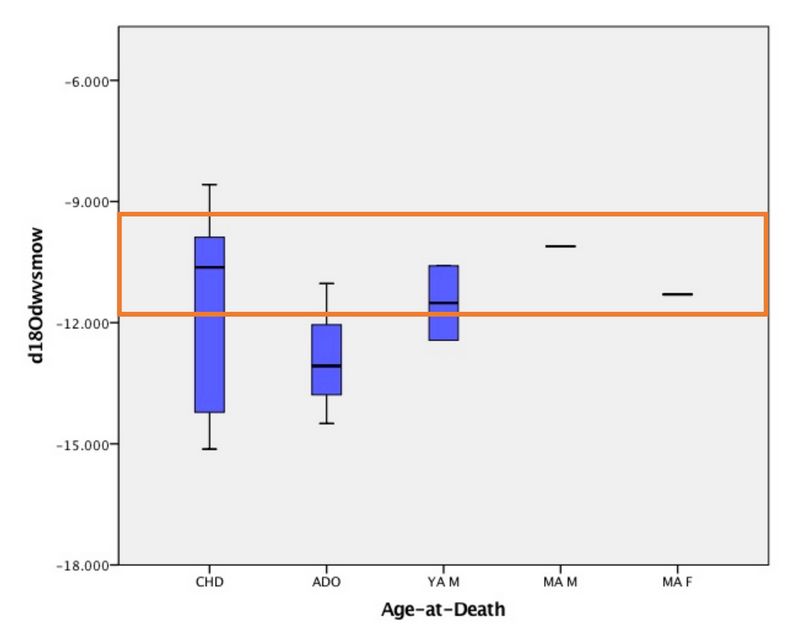
The ongoing oxygen isotope analysis thus far indicates that the individuals sampled exhibit values that fall outside the mean range of drinking water for the Moche Valley and watershed (fig.14). Heterogeneity of the oxygen isotope data among individuals together with the high frequency of cranial modification types suggests that the sample of sacrificed individuals exhibit residential origins that may include individuals born outside the Moche Valley in neighboring river valleys or locations in higher-altitude regions outside the Moche watershed.
Fig.14: Plot of 18Odw values from El Pollo (n=14), with bar noting the approximate range for Moche watershed 18Odw (mean range -9.2 to -11.6‰, from Gagnon et al. 2015).
Conclusions:
These preliminary results indicate that El Pollo was likely a location for sacrificial events similar to that of Huanchaquito-Las Llamas and Pampa la Cruz. Many of these artifacts found alongside human sacrifices are known to signify ritual activity throughout the Chimú Empire.
Spondylus, a marine bivalve found in the warm Equatorial waters off the west coast of South America, was considered by the Chimú a valuable, exotic item and was acquired through long distance trade (Pillsbury 1996). The shell’s presence and visual representation in elite tombs and ceremonial architecture throughout the Chimú Empire is interpreted to convey the bivalve’s symbolic association to ritual practices concerning agricultural fertility (Mackey 1987, Mackey and Klymyshyn 1990, Mackey 2006, Pillsbury 1996).
Similarly, pods of Nectandra sp. seeds have been incorporated into funerary contexts and associated with human sacrifices throughout the north coast of Peru (see Cutright 2013, Eeckhout 2006, Klaus et al 2010, Moytoya Vera 2015). Extract of Nectandra sp. possesses narcotic, paralytic and anticoagulant properties (Montoya Vera 2015). Various scholars have argued that the seed’s use may have been intended to drug or immobilize and sedate sacrificial victims and prevent their wounds from clotting (see Bourget 1994, Klaus et al. 2010, Montoya Vera 2015).
The addition of adults with evidence of sacrifice is a novel patterns and merits additional research. The lack of cut thoraces on the female and middle adult males suggests they were sacrificed in a manner that is not identifiable skeletally. Why these adults were deposited alongside sacrificed children remains unclear. Overall, individuals were in good health at the time of death, indicating that only individuals of good health were selected for sacrifice. The radiocarbon dates also indicate that nonadults were targeted for sacrifice during both Chimú and Inka occupations of the site, with the mode of sacrifice remaining constant.
The stable isotope results suggest that victims consumed diets that consist largely of locally procured items, such as maize as well as marine proteins. The high frequency of cranial modification types together with the oxygen isotope data suggest that the sample consists of individuals born outside the Moche Valley or from higher-altitude regions outside the Moche watershed.
Given the radiocarbon results, stable isotope data, and the proximality of El Pollo and Pampa la Cruz to the Chimú capital Chan Chan, these results suggest that sacrifice initially functioned to maintain the sociopolitical and religion agendas of elites ruling from the nearby capital. Given that two sacrificial events at El Pollo are contemporaneous with periods of Chimú expansion to the north in the 14th and 15th centuries, and the presence of victims from regions outside the Moche watershed, it is possible that victims were selected from newly conquered areas and relocated to the Chimú core as part of rituals functioning to commemorate and display the power and authority of the empire. The continuation of sacrifice following Inka dismantlement of the Chimú Empire and imposition of foreign rule suggests rituals may have been understood as a powerful local institution that the Inka strategically modified and mimicked to maintain the social and spiritual stability of a newly conquered region.
.
Together, this evidence implies sacrifice of children and adults served both ritual and socio-political purposes for the consolidation of north coast under the reign of the Chimú and the Inca Empires, a perspective that will be discussed at length in the applicant’s dissertation.
Future Directions:
This study provide new insights into anthropological discussions of migration and subsistence practices in the past. Analysis of serial sections of hair is nearing completion and will demonstrate if individuals experienced dietary and/or residential shifts during the months prior to death. Specifically, the carbon and nitrogen isotopes from hair will be used to reconstruct protein and plant components of diet to distinguish between diets of inhabitants at Chan Chan and diets of individuals from hinterland communities. Sulphur isotopes from hair will distinguish between migrant diets from continental interiors and populations living in and around Chan Chan, a coastal city under the ‘sea spray effect.’
Ultimately, this study will provide new insight on childhood via analysis of a large, well-preserved sample to illustrate that children are not invisible in the past but contributed to ancient societies. This study is an opportunity to better understand the role of child sacrifice in the creation and maintenance of empires.
Bibliography:
Akkermans, P.M.M.G., Schwartz, G.M., (2003). The Archaeology of Syria: From Complex Hunter-Gatherers to Early Urban Societies (C. 16,000–300 B.C.). Cambridge University Press, Cambridge.
Billman, B. R., Bardolph, D., Hudson, J., & Briceño Rosario, J. (2020). Fisherman, Farmers, Rich Man, Poor Man, Weaver, Parcialidad Chief? Household Archaeology at Cerro la Virgen, a Chimú Town within the Hinterland of Chan Chan. In G. P. Sandweiss, Maritime Communities of the Ancient Andes (pp. 265-300). Gainesville: University Press of Florida.
Carrasco, D. (1999). City of Sacrifice: The Aztec Empire and the Role of Violence in Civilization. Boston: Beacon Press.
Cheung, C., Jing, Z., Tang, J., Weston, D.A., Richards, M.P. (2017). Diets, social roles, and geographical origins of sacrificial victims at the royal cemetery at Yinxu, Shang China: New evidence from stable carbon, nitrogen, and sulfur isotope analysis. Journal of Anthropological Archaeology. 48: 28-45.
Cobo, F.B. (1653) Inca Religion and Customs, translated by Hamilton, R. (1990). University of Texas Press: Austin.
Domínguez Vergara, J. (2019). Relaciones núcleo - periferia entre asentamientos domésticos Chimú Tardío y Chimú Inca en el valle de Moche: el caso La Joyada. Unpublished Masters Thesis. Univeridad Nacional de Trujillo.
Gagnon, C. M., Andrus, C. F., Ida, J., & Richardson, N. (2015). Local water source variation and experimental Chic de Maíz brewing: Implications for interpreting human hydroxyapatite d18O values in the Andes. Journal of Archaeological Science: Reports, 4, 174-181.
Holt, J.Z. (2009). Rethinking the Ramey State: Was Cahokia the Center of a Theatre State? American Antiquity, 74(2): 231-254
Klaus, H. D., Turner, B. L., Saldaña, F., Castillo, S., & Wester, C. (2016). Human Sacrifice at the Chotuna-Chornancap Archaeological Complex. In H. D. Toyne, Ritual Violence in the Ancient Andes (pp. 178-210). Austin: University of Texas Press.
Lloyd, A.B., (2010). A Companion to Ancient Egypt. John Wiley & Sons, New York.
Moore J.D., Mackey C.J. (2008) The Chimú Empire. In: Silverman H., Isbell W.H. (eds) The Handbook of South American Archaeology. Springer, New York, NY
Pollock, S., (1999). Ancient Mesopotamia: The Eden That Never Was. Cambridge University Press, London.
Pozorski, S. G. (1979). Prehistoric Diet and Subsistance of the Moche Valley, Peru. World Archaeology, 11(2), 163-184.
Prieto, G., Verano, J. W., Castillo, F., Tschinkel, K., Witt, R., Flores de la Oliva, L., & Chachapoyas, A. (2021). Pampa la Cruz: New Evidence of Child and camelid Sacrifice during the Late Intermediate Period and Late Horizon on the North Coast of Peru. 61st Institute of Andean Studies annual meeting.
Prieto G, Verano JW, Goepfert N, Kennett D, Quilter J, LeBlanc S, et al. (2019) A mass sacrifice of children and camelids at the Huanchaquito-Las Llamas site, Moche Valley, Peru. PLoS ONE 14(3): e0211691. https://doi.org/10.1371/ journal.pone.0211691
Reinhard, R. Ceruti, C. (2005). Sacred mountains, ceremonial sites, and human sacrifice among the Incas. Archaeoastronomy XIX: 1-43.
Schug, G.E., Gray, K., Mushrif-Tripathy, V., Sankhyan, A.R. (2012). A peaceful realm? Trauma and social differentiation at Harappa. International Journal of Paleopathology. 126(2): 111-120.
Schwartz, G.M. (2017). The Archaeological Study of Sacrifice. Annual Review of Anthropology. 46: 223-240.
Szpak, P., Millaire, J.-F., White, C. D., & Longstaffe, F. J. (2012). Influence of seabird guano and camelid dung fertilization on the nitrogen isotopic composition of field-grown maize (Zea mays). Journal of Archaeological Science, 39, 3721-3740.
Szpak, P., White, C. D., Longstaffe, F. J., & Millaire, J.-F. V. (2013). Carbon and Nitrogen Isotopic Survey of Northern Peruvian Plants: Baselines for Paleodietary and Paleoecological Studies. PLoS ONE, 8(1), e53763.
Toyne, M. J. (2011). Interpretations of Pre-Hispanic Ritual Violence at Tucume, Peru, from Cut Mark Analysis. Latin American Antiquity , 22(4), 505-523.
Toyne, M. J., White, C. D., Verano, J. W., Uceda Castillo, S., Millaire, J.-F., & Longstaffe, F. J. (2014). Residential histories of elites and sacrificial victims at Huacas de Moche, Peru, as reconstructed from oxygen isotopes. Journal of Archaeological Science, 42, 15-28.
Trigger, B. (2003). Understanding Early Civilizations: A Comparative Study. Cambridge: Cambridge University Press.
Tung, T.A. (2012). Violence, Ritual, and the Wari Empire: A Social Bioarchaeology of Imperialism in the Ancient Andes. Gainesville: University of Florida Press.
Watts, J., O. Sheehand, Q.D. Atkinson, J. Bulbulia, R.D. Gray (2016). Ritual human sacrifice promoted and sustained the evolution of stratified societies. Nature. 532: 228-213..
Recent Foundation grants: general Archaeology Grants Program w/map
Copyright © 2022 Rust Family Foundation